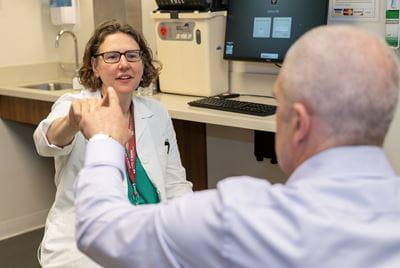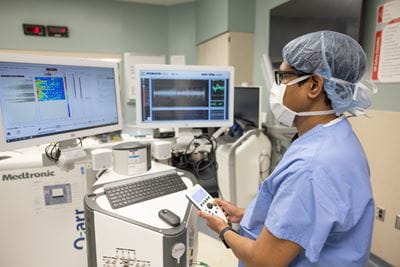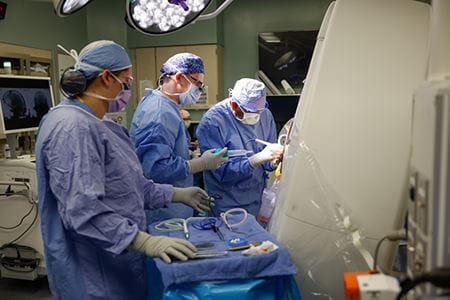One had to give up painting ornaments to gift her loved ones for a decade. Another worried he wouldn’t be able to share the special dance with his daughter on her wedding day.
Both of these patients were able to successfully resume hobbies they once thought might never be possible due to a disabling neurological disorder after undergoing deep brain stimulation surgery.
The minimally invasive surgical procedure is led by stereotactic and functional neurosurgery specialists in the Department of Neurological Surgery and movement disorder specialists in the Department of Neurology at the Indiana University School of Medicine. These experts are spearheading clinical excellence and advancing research to improve patient outcomes and clinical trials.
During the deep brain stimulation procedure, electrodes are implanted in specific areas of the brain associated with a particular disease. A programmable electrical stimulator, like a cardiac pacemaker, is then placed in the chest and delivers electric pulses to the target brain region to help regulate abnormal movements.
Experts say more than 250,000 people worldwide have undergone deep brain stimulation since it began in the 1980s.
The procedure is commonly used to treat Parkinson disease, essential tremor, epilepsy and dystonia. It’s also used for psychiatric conditions such as obsessive-compulsive disorder and depression.
“It can be quite life-altering,” said Elizabeth Zauber, MD, professor of clinical neurology and director of the Parkinson’s Foundation Center of Excellence at the IU School of Medicine.
“I’ve seen people with tremor so severe that they couldn’t even put their glasses on, or someone had to help feed them,” Zauber said. “When they undergo deep brain stimulation and we turn the stimulator on, they have minimal to no tremor. In some cases, the change can be so immediate and so profound that the whole room ends up crying in tears of joy.”
David A. Purger, MD, PhD, assistant professor of neurological surgery and an Indiana University Health Foundation Master Clinician, said the IU School of Medicine — the largest medical school in Indiana and the United States — is a leader when it comes to “actively trying to make this procedure better with every single one that we do.”
“We use state-of-the-art techniques to make deep brain stimulation safer,” Purger said. “We’re also one of the first sites to use new, more advanced electrodes that have just come out onto the market.
“It’s really that spirit of research and innovation that does not exist anywhere else in Indiana.”
New, innovative tech adapts to patients’ needs
When Zauber joined the IU School of Medicine roughly 16 years ago, there was only one company making deep brain stimulation devices. Today, three companies are in business, which Zauber said has led to a lot of innovation and changes in technology.

One update includes the ability to continuously monitor brain signals. Neurologists and neurophysiologists have long recorded brain signals in the operating room during electrode implantation, but now these signals can also be recorded while patients are at home, going about their regular activities.
“These recordings are not only used to optimize a patient’s program settings,” Zauber said, “but that data is also a useful tool for further research.”
Recent advancements have enabled these devices to adjust stimulation setting based on patients’ brain activity.
“Typically, adjustments were made by us. A patient would have come into the office, report more tremors, for example, and we upped the electrical settings to be fixed through the day,” Zauber said. “We now can set the stimulator where it can be recording the brain during daily tasks. At certain times of the day, it gives more electricity, and at other times of the day, it gives less electricity to optimize patient symptom control.”
Jason Schwalb, MD, MBA, the Betsey Barton Professor of Neurological Surgery, said the team at the IU School of Medicine hopes to expand novel advancements in deep brain stimulation technology, programming and research in the coming years.
“We want to offer full services to every patient in the state of Indiana and beyond who could benefit from this treatment,” said Schwalb, an active clinical trials investigator and nationally sought advisor to industry on stereotactic and functional neurosurgery.
“Our goal is to contribute to further refinement, develop new targets and develop safer, more accurate techniques to make deep brain stimulation an even more routine procedure.”
Expanding expertise in deep brain stimulation
In addition to technology advancements, the deep brain stimulation team at the IU School of Medicine has also undergone extensive growth since the first procedure was performed in 1997 by Thomas Witt, MD, associate professor of neurological surgery, and Robert M. Worth, MD, PhD, professor emeritus of clinical neurological surgery.
Purger and Schwalb both joined the Department of Neurological Surgery in 2024, and Sohail Noor, PhD, assistant professor of neurological surgery, joined the department in February to lead intraoperative neurophysiology for brain mapping during surgeries.
Noor directs the Noor Precision Neuromodulation Lab, which aims to develop circuit-specific neuromodulation strategies to treat neuropsychiatric conditions and study biomarkers for adaptive deep brain stimulation.
“The teamwork at the IU School of Medicine is remarkable,” said Noor, who conducted his postdoctoral research on the biophysical mechanisms of deep brain stimulation at Case Western Reserve University and Duke University.

“All these experts are co-located in a single building, the Neuroscience Center, facilitating collaboration through frequent, in-person interactions. Moreover, both the leadership at the IU School of Medicine and IU Health are strongly committed to advancing research in this rapidly growing field. Together, these strengths position our program to deliver cutting-edge patient care and drive innovation in neuromodulation.”
Today, the interdisciplinary deep brain stimulation clinical team is comprised of three adult and two pediatric neurosurgeons, four movement disorders neurologists, a neurophysiologist, neuropsychologists, advanced practice providers and registered nurses. Residents and fellows also regularly train with the team to learn more about the deep brain stimulation process.
Carla Van Amburg, BSN, RN, clinical nurse-ambulatory navigator with IU Health, said cases have increased so much in recent years that the team went from meeting monthly to meeting every Monday morning to discuss deep brain stimulation candidates.
Those weekly meetings are a collaborative effort between neurosurgeons, neurologists, neurophysiologists, neuropsychologists and nurses and can also include clinicians from other departments such as psychiatry and otolaryngology.
“The exponential growth in the team has been wonderful,” said Van Amburg, who has been a part of the team since 2003. “Patients don’t have to wait a year or almost two to have surgery. They're getting the treatments they need quickly.”
